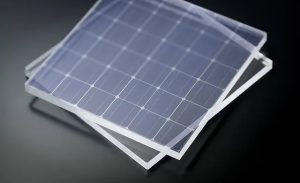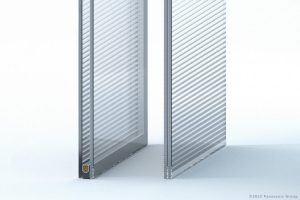The glass industry in Mexico has a professional business platform, designed for the exchange of information, the presentation of products, services and technological innovation, including training sessions and lectures on current trends within the sector. Glasstech Mexico / Doors & Windows, will be held from July 9 to 11, 2024 at Expo Guadalajara. Please register as a trade visitor here: https://shorturl.at/J21b3
Photovoltaic Glass
(via PV Magazine)
What is photovoltaic glass
Photovoltaic glass, also known as solar glass or solar transparent glass, is an innovative material that combines the properties of a photovoltaic solar panel with the aesthetic and functional characteristics of glass. It is mainly used in architectural applications, such as windows, facades and skylights, to generate electricity from solar energy.
How this glass works
This type of glass works by using solar cells integrated directly into its structure. These solar cells are composed of thin layers of semiconductor materials, such as amorphous silicon or cadmium telluride, which convert sunlight into electricity through the photovoltaic effect.
When sunlight strikes the photovoltaic glass, the photons of light excite electrons in the semiconductor material, creating an electric current. This current is collected through electrical connections at the edges of the glass, and can be used to power electronic devices or fed into the electrical grid.
Why photovoltaic glass is transparent
One of the distinguishing characteristics of glass is its ability to be transparent. This is achieved through the use of thin, transparent semiconductor materials, which allow most of the visible light to pass through the glass without significant obstruction.
Although the glass is not completely transparent, as it has some opacity due to the semiconductor layers and electrical contacts, it still allows a sufficient amount of visible light to illuminate interior spaces and maintain visual transparency. This makes it ideal for architectural applications, as it combines solar energy generation with the functionality of windows and facades.


Characteristics of this type of glass
Photovoltaic glass has several characteristics that make it attractive compared to conventional solar panels:
- Transparency: Although not completely transparent, the glass allows visible light to pass through, making it suitable for architectural applications where natural lighting is required.
- Aesthetics: Photovoltaic glass offers a sleek, modern appearance, blending harmoniously into the architectural design.
- Versatility: It can be used in a wide range of applications, such as windows, facades, skylights and design elements, allowing the vertical space of buildings to be used for solar energy generation.
- Efficiency: Although the performance of photovoltaic glass may be slightly lower than that of conventional solar panels, it is still capable of converting a significant amount of solar energy into electricity.
What is the performance of this type of glass?
The efficiency of glass refers to the amount of solar energy it can convert into electricity. Although performance can vary depending on the design and specific characteristics of the glass, in general, glass has a slightly lower performance than conventional solar panels or plates.
Performance is measured in terms of conversion efficiency, which is the proportion of incident solar energy that is converted into electricity. On average, photovoltaic glass can have efficiencies ranging from 5% to 15%. It is important to note that these figures are approximate and can vary depending on the manufacturer and the specific type of PV glass used.
PV glass performance can also be affected by external factors such as glass tilt and orientation, shading and ambient temperature. Therefore, it is critical to perform a detailed analysis of the specific location and conditions before implementing glass in a project.
Although the performance of photovoltaic glass may be slightly lower than conventional solar panels, it is still an attractive option due to its ability to combine energy generation with architectural functionality.
How much photovoltaic glass typically costs
The price of photovoltaic glass can vary depending on a number of factors, such as size, type of glass, type of solar panel, and the type of glass used.
In addition, supply and demand in the market can also influence price.
In general, photovoltaic glass tends to be more expensive than conventional glass used in architectural applications. This is due to the additional manufacturing processes required to incorporate the solar cells into the glass and ensure its transparency. The price of photovoltaic glass is usually calculated in terms of cost per square meter (m²). In today’s market, prices can vary from around USD 200 to 400 per square meter, depending on the specifications and characteristics of the glass. It is important to note that the price of photovoltaic glass can be justified by the long-term benefits it offers, such as electricity generation and reduction in conventional energy consumption. In addition, when integrated into architectural elements, it can contribute to energy savings and sustainable building design.
It is advisable to obtain quotations from different suppliers and conduct a detailed cost-benefit analysis before making a purchase decision. It is also important to consider the quality and reputation of the manufacturer to ensure reliable and durable PV glass.
Why use photovoltaic glass for facades?
This type of glass is used on building facades for several key reasons:
- Clean Energy Generation: Photovoltaic glass incorporates solar cells that convert sunlight into electricity. By using it on building facades, the available surface area is used to passively generate clean energy, reducing dependence on conventional energy sources and contributing to sustainability.
- Energy Efficiency: By generating electricity from sunlight, photovoltaic glass can power lighting systems and other electrical devices in the building. This can reduce energy demand from the power grid and lower operating costs.
- Integrated Design: Photovoltaic glass can be elegantly integrated into a building’s architectural design, serving as both a building material and an energy source. This allows architects and designers to create more sustainable buildings without compromising on aesthetics.
- Improved Thermal and Acoustic Insulation: Some photovoltaic glass is designed to improve thermal and acoustic insulation, contributing to energy efficiency and indoor comfort.
- Vertical Space Utilization: In densely populated urban areas, space on building facades is valuable. Solar glass takes advantage of this vertical space for energy generation, which is especially relevant in urban environments where the availability of rooftop space may be limited.
In short, solar glass on facades combines the functionality of solar energy generation with architectural aesthetics and energy efficiency, making it an attractive option for sustainable and environmentally friendly buildings.
The glass industry in Mexico has a professional business platform, designed for the exchange of information, the presentation of products, services and technological innovation, including training sessions and lectures on current trends within the sector. Glasstech Mexico / Doors & Windows, will be held from July 9 to 11, 2024 at Expo Guadalajara. Please register as a trade visitor here: https://shorturl.at/J21b3


